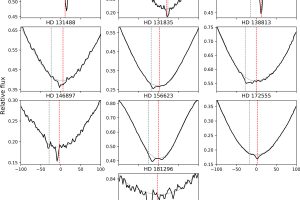Gas in dusty discs. Published on A&A the study: “The co-existence of hot and cold gas in debris discs” of I. Rebollido (Universidad Autónoma de Madrid)

Some main sequence stars shows an excess of emission in far infrared with respect to photospheric values. This emission is thought to be thermal emission of dust grains and solid bodies associated with a debris disk orbiting around stars. This hypothesis has been confirmed when some of these disks, such as the one orbiting the star Fomalhaut, have been directly observed. The dust in debris disks can be of first generation, e.g. the residual of the planet formation process occurred in the protoplanetary disk, or belonging to a second generation, e.g. produced by collisions between planetesimals, comets, of solid bodies in general.
Despite the idea that debris disks should contain only a little of gas, in some cases the emission from gas molecules such as CO has been observed. For instance, it has been observed from the debris disks around β Pic (Dent et al. 2014) and 49 Cet (Hughes et al. 2008). This gas is cold (10-20 K) and it is orbiting at distances between 10 and >100 AU (1 AU is the average distance between Earth and the Sun). Also this gas can be primordial or produced by vaporisation in solid bodies, collisions or outgassing of comets.
In β Pic it has also been discovered the presence of hot gas by the evidence of non photospheric absorption features in stellar spectrum. This gas is thought to orbit the star at about 0.5 AU, having a temperature of 1000-2000 K, and being produced by exocomets moving toward the star.
This is the framework of the study “The co-existence of hot and cold gas in debris discs” of I. Rebollido (Departamento Física Teórica, Universidad Autónoma de Madrid) published in Astronomy & Astrophysics with the collaboration of the astronomer J. Maldonado of INAF – Astronomical Observatory of Palermo. The authors have analysed high-resolution spectra of all the stars with debris disks known to contain cold gas, searching for the presence of non photospheric absorption features in the lines Ca II K (λ 3933.66 Å), Ca II H (λ3968.47 Å) and Na I D (λλ 5889.95/5895.92 Å). These signatures for the presence of hot gas have been observed in 10 out of 15 analysed stars, showing that hot gas is present in most of these debris disks.
The figure (link) shows the median Ca II K line profile observed in the stars analysed in this paper.
